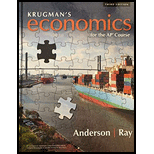
a)
The value of the spending multiplier when MPC in an economy is 0.8 and the government increases government purchases by $60 million with the absence of taxes, international trade, and changes in the aggregate price level.
a)
Explanation of Solution
In this case, the spending multiplier would be calculated by using the marginal propensity to consume in the following way:
MPC in an economy is 0.8
Increases in government purchases is $60 million
Then, the spending multiplier:
Introduction: The marginal propensity to consume refers to the proportion of the amount which is spent on the consumption of goods and services rather than keeping the amount as savings.
The spending multiplier represents the impact of change in autonomous spending on total spending and demand in the economy of the country, which may increase or decrease.
And, a tax multiplier is used to identify the final increase in the level of real
b)
The real GDP change due to the increase in government purchases.
b)
Explanation of Solution
The change in real GDP due to an increase in government spending on goods and services would be:
Increases in government purchases is $60 million
Then change in real GDP:
Introduction: The marginal propensity to consume refers to the proportion of the amount which is spent on the consumption of goods and services rather than keeping the amount as savings.
The spending multiplier represents the impact of change in autonomous spending on total spending and demand in the economy of the country which may increase or decrease.
And, a tax multiplier is used to identify the final increase in the level of real GDP with the change in tax rates.
c)
The size of the effect on real GDP if there is a decrease in MPC.
c)
Explanation of Solution
The size of the effect on real GDP would decrease when there is a decrease in the marginal propensity to consume because the consumption level of individuals is decreasing in the economy, which causes the real GDP to fall.
Introduction: The marginal propensity to consume refers to the proportion of the amount which is spent on the consumption of goods and services rather than keeping the amount as savings.
The spending multiplier represents the impact of change in autonomous spending on total spending and demand in the economy of the country, which may increase or decrease.
And, a tax multiplier is used to identify the final increase in the level of real GDP with the change in tax rates.
d)
The size of the spending multiplier when there is a relaxation of no taxes
d)
Explanation of Solution
In this case, the spending multiplier would be 1/(1-MPC).
And, a decrease in the marginal propensity to consume will increase the denominator as (1-MPC), which means there would be a decline in the spending multiplier.
Introduction: The marginal propensity to consume refers to the proportion of the amount which is spent on the consumption of goods and services rather than keeping the amount as savings.
The spending multiplier represents the impact of change in autonomous spending on total spending and demand in the economy of the country, which may increase or decrease.
And, a tax multiplier is used to identify the final increase in the level of real GDP with the change in tax rates.
e)
Real GDP change due to an equal increase in government spending and tax rates
e)
Explanation of Solution
In this case, the real GDP change would decrease when there is an equal increase in government spending and tax rates by $60 million.
The real GDP would decrease by:
Introduction: The marginal propensity to consume refers to the proportion of the amount which is spent on the consumption of goods and services rather than keeping the amount as savings.
The spending multiplier represents the impact of change in autonomous spending on total spending and demand in the economy of the country, which may increase or decrease.
And, a tax multiplier is used to identify the final increase in the level of real GDP with the change in tax rates.
Chapter 21 Solutions
Krugman's Economics For The Ap® Course

 Principles of Economics (12th Edition)EconomicsISBN:9780134078779Author:Karl E. Case, Ray C. Fair, Sharon E. OsterPublisher:PEARSON
Principles of Economics (12th Edition)EconomicsISBN:9780134078779Author:Karl E. Case, Ray C. Fair, Sharon E. OsterPublisher:PEARSON Engineering Economy (17th Edition)EconomicsISBN:9780134870069Author:William G. Sullivan, Elin M. Wicks, C. Patrick KoellingPublisher:PEARSON
Engineering Economy (17th Edition)EconomicsISBN:9780134870069Author:William G. Sullivan, Elin M. Wicks, C. Patrick KoellingPublisher:PEARSON Principles of Economics (MindTap Course List)EconomicsISBN:9781305585126Author:N. Gregory MankiwPublisher:Cengage Learning
Principles of Economics (MindTap Course List)EconomicsISBN:9781305585126Author:N. Gregory MankiwPublisher:Cengage Learning Managerial Economics: A Problem Solving ApproachEconomicsISBN:9781337106665Author:Luke M. Froeb, Brian T. McCann, Michael R. Ward, Mike ShorPublisher:Cengage Learning
Managerial Economics: A Problem Solving ApproachEconomicsISBN:9781337106665Author:Luke M. Froeb, Brian T. McCann, Michael R. Ward, Mike ShorPublisher:Cengage Learning Managerial Economics & Business Strategy (Mcgraw-...EconomicsISBN:9781259290619Author:Michael Baye, Jeff PrincePublisher:McGraw-Hill Education
Managerial Economics & Business Strategy (Mcgraw-...EconomicsISBN:9781259290619Author:Michael Baye, Jeff PrincePublisher:McGraw-Hill Education





